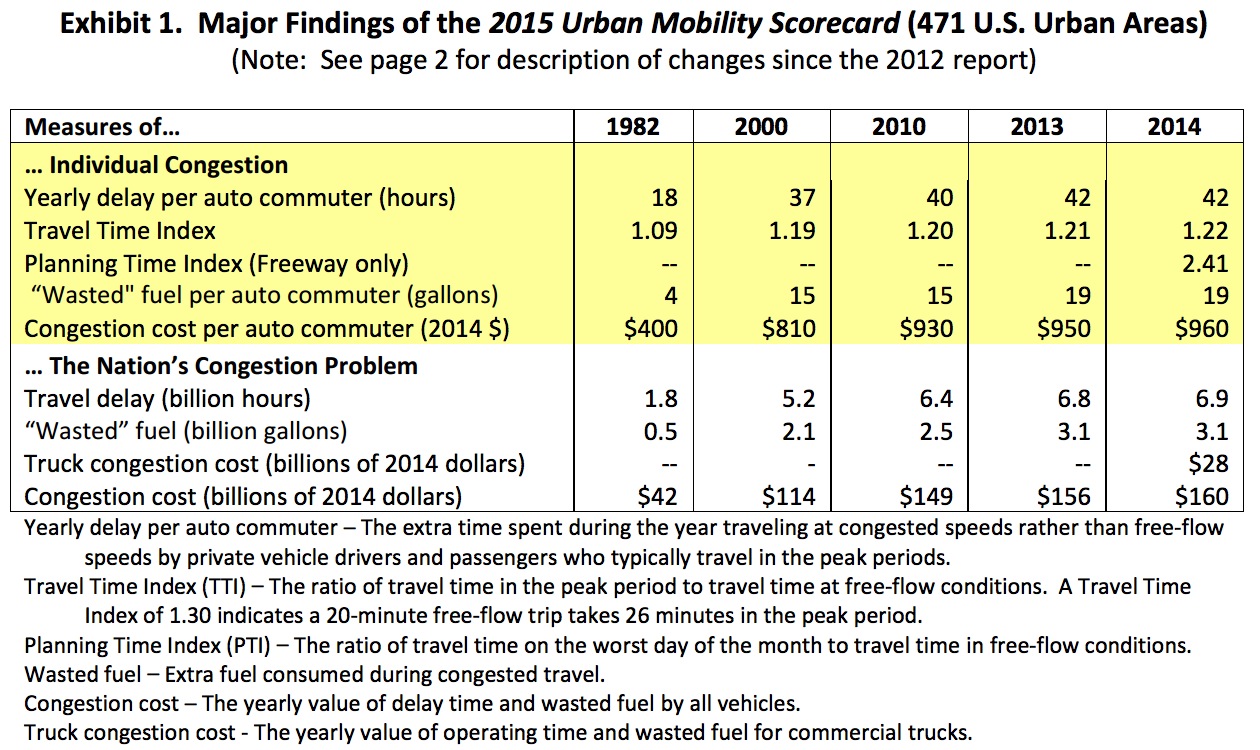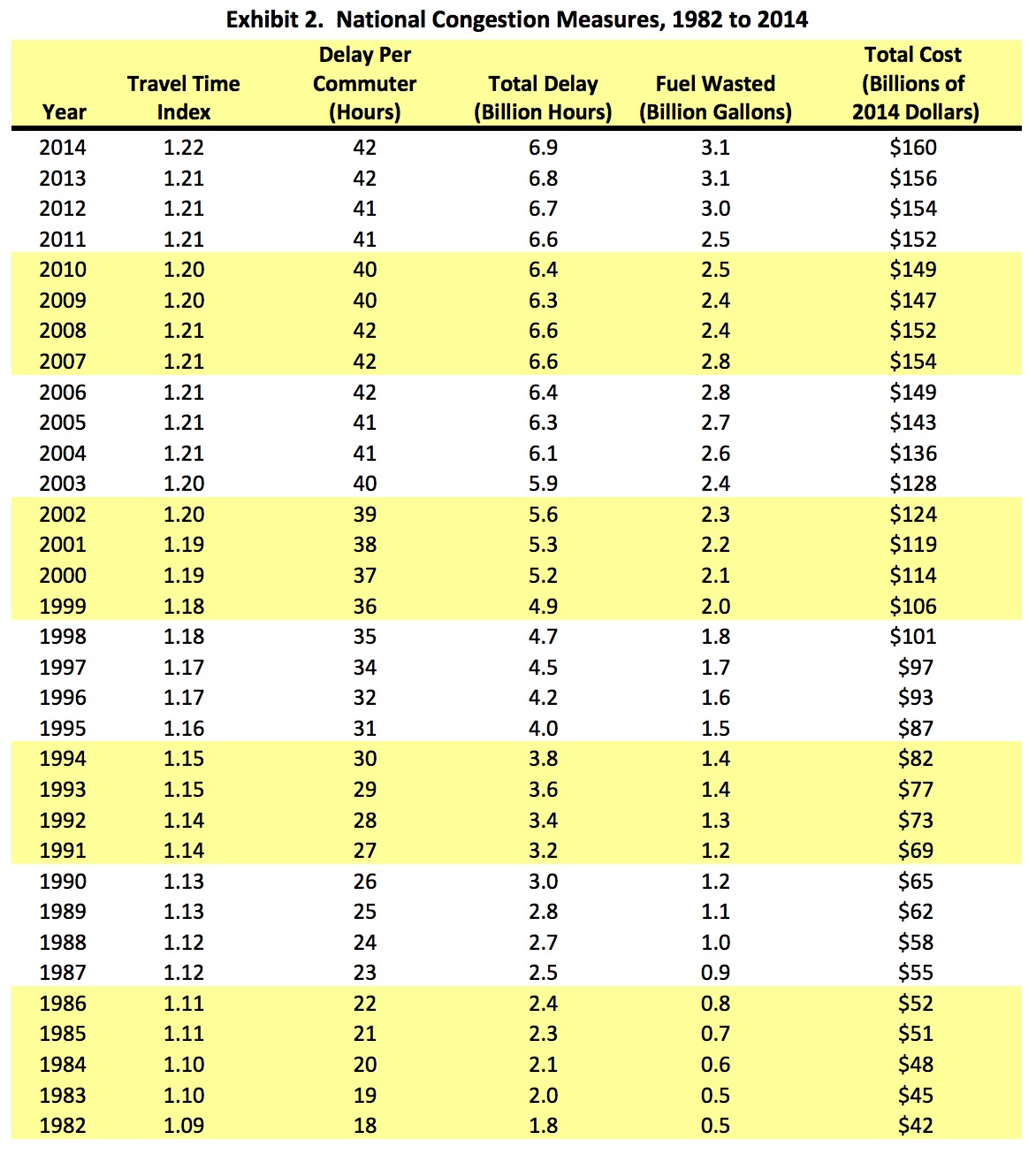TEXAS A&M TRANSPORTATION INSTITUTE
2015 Urban Mobility Scorecard
The national congestion recession is over. Urban areas of all sizes are experiencing the challenges seen in the early 2000s – population, jobs and therefore congestion are increasing. The U.S. economy has regained nearly all of the 9 million jobs lost during the recession and the total congestion problem is larger than the pre-recession levels. For the report and congestion data on your city, see: http://mobility.tamu.edu/ums.
The data from 1982 to 2014 (see Exhibit 1) show that, short of major economic problems, congestion will continue to increase if projects, programs and policies are not expanded.
- The problem is very large. In 2014, congestion caused urban Americans to travel an extra 6.9 billion hours and purchase an extra 3.1 billion gallons of fuel for a congestion cost of $160 billion. Trucks account for $28 billion (17 percent) of that cost, much more than their 7 percent of traffic.
- From 2013 to 2014, 95 of America’s 100 largest metro areas saw increased traffic congestion, from 2012 to 2013 only 61 cities experienced increases.
- In order to reliably arrive on time for important freeway trips, travelers had to allow 48 minutes to make a trip that takes 20 minutes in light traffic.
- Employment was up by more than 500,000 jobs from 2013 to 2014 (1); if transportation investment continues to lag, congestion will get worse. Exhibit 2 shows the historical national congestion trend.
- More detailed speed data on more roads and more hours of the day from INRIX (2) a leading private sector provider of travel time information for travelers and shippers, have caused congestion estimates in most urban areas to be higher than in previous Urban Mobility Scorecards.
The best mobility improvement programs involve a mix of strategies – adding capacity of all kinds, operating the system to get the ‘best bang for the buck,’ travel and work schedule options and encouraging homes and jobs to be closer. This involves everyone – agencies, businesses, manufacturers, commuters and travelers. Each region should use the combination of strategies that match its goals and vision. The recovery from economic recession has proven that the problem will not solve itself.
Turning Congestion Data Into Insight (And the New Data Providing a More Accurate View)
The 2015 Urban Mobility Scorecard is the 4th that TTI and INRIX have prepared. The data behind the 2015 Urban Mobility Scorecard are hundreds of speed data points on almost every mile of major road in urban America for almost every 15-minute period of the average day of the week. For the congestion analyst, this means 900 million speeds on 1.3 million miles of U.S. streets and highways – an awesome amount of information. For the policy analyst and transportation planner, this means congestion problems can be described in detail, and solutions can be targeted with much greater specificity and accuracy.
Key aspects of the 2015 Urban Mobility Scorecard are summarized below.
- Congestion estimates are presented for each of the 471 U.S. urban areas. Improvements in the INRIX traffic speed data and the data provided by the states to the Federal Highway Administration (3) means that for the first time the Urban Mobility Scorecard can provide an estimate of the congestion effects on residents of every urban area. See Table 4 for a few 2014 congestion measures in each of the 370 urban areas that have not been intensively studied.
- Speeds collected by INRIX every 15 minutes from a variety of sources every day of the year on almost every major road are used in the study. The data for all 96 15-minute periods of the day makes it possible to track congestion problems for the midday, overnight and weekend time periods. For more information about INRIX, go to www.inrix.com.
- This data improvement created significant difference in congestion estimates compared with past Reports/Scorecards – more congestion overall, a higher percentage of congestion on streets and different congestion estimates for many urban areas. As has been our practice, past measure values were revised to provide our best estimate of congestion trends.
- More detail is provided on truck travel and congestion. Estimates of truck volume during the day were developed (in past reports, trucks were assumed to have the same patterns as cars travel). This changed delay and fuel estimates in different ways for several cities.
- The measure of the variation in travel time from day-to-day now uses a more representative tripbased process (4) rather than the old dataset that used individual road links. The Planning Time Index (PTI) is based on the idea that travelers want to be on-time for an important trip 19 out of 20 times; so one would be late to work only one day per month (on-time for 19 out of 20 work days each month). For example, a PTI value of 1.80 indicates that a traveler should allow 36 minutes to make an important trip that takes 20 minutes in low traffic volumes. The new values are lower, and closer to real-world experience.
- Many of the slow speeds that were formerly considered ‘too slow to be a valid observation’ are now being retained in the INRIX dataset. Experience and increased travel speed sample sizes have increased the confidence in the data.
- Where speed estimates are required, the estimation process is benefitting from the increased number of speeds in the dataset. The methodology is described on the mobility study website (5).
More information on the performance measures and data can be found at: http://mobility.tamu.edu/methodology/
Download full version (PDF): 2015 Urban Mobility Scorecard
About the Texas A&M Transportation Institute
tti.tamu.edu
Texas A&M Transportation Institute (TTI) develops solutions to the problems and challenges facing all modes of transportation. The Institute conducts over 600 research projects annually with over 200 sponsors at all levels of government and the private sector. In the laboratory and the classroom,TTI researchers help prepare students for transportation careers.








 RSS Feed
RSS Feed